Manual Brake Conversion
- Thread starter malibudave1978
- Start date
Welcome!
By registering with us, you'll be able to discuss, share and private message with other members of our community.
SignUp Now!You are using an out of date browser. It may not display this or other websites correctly.
You should upgrade or use an alternative browser.
You should upgrade or use an alternative browser.
Fantastic! Is that a 7/8"? What did you use for a pushrod? Modify the PM pedal at all?
Sorry for all the questions, but I was planning on doing this swap this season
Scott Atk
Senior Member
- Joined
- May 25, 2001
- Messages
- 2,656
Here's a quote from the Wilwood site:Looks like it does have oblong holes to allow for multiple mount spacing... Cool!
Bolt-on Installation
The mounting flange is slotted to accommodate installation on bolt centers between 3.22” and 3.40”. That makes it a simple bolt-on to many OE mounts including the popular Chrysler, Corvette, GM, and Ford Mustang master cylinder bolt patterns. The body also features two through-hole mounts on 6.40” centers for side mounting to frame members or other secure elements of the chassis.
Bolt-on Installation
The mounting flange is slotted to accommodate installation on bolt centers between 3.22” and 3.40”. That makes it a simple bolt-on to many OE mounts including the popular Chrysler, Corvette, GM, and Ford Mustang master cylinder bolt patterns. The body also features two through-hole mounts on 6.40” centers for side mounting to frame members or other secure elements of the chassis.
malibudave1978
Member
- Joined
- Apr 3, 2005
- Messages
- 80
Weight differences between Mater Cylinders.
Weight of Cast Iron 7/8" Manual Brake Master Cylinder
3 lbs 5 1/8 ounce
Weight of Aluminum Step Bore S-10 Master (24mm / 1 1/4" step bore)
2 lbs 8 1/4 ounce - difference of 12 7/8 ounces or a little over 3/4 lbs over the cast iron unit
Weight of an Aluminum Mopar / Strange style master cylinder
2 lbs 2 3/4 ounce - difference of 1 lb 2 3/8 ounces over the cast iron unit
Weight of Cast Iron 7/8" Manual Brake Master Cylinder
3 lbs 5 1/8 ounce
Weight of Aluminum Step Bore S-10 Master (24mm / 1 1/4" step bore)
2 lbs 8 1/4 ounce - difference of 12 7/8 ounces or a little over 3/4 lbs over the cast iron unit
Weight of an Aluminum Mopar / Strange style master cylinder
2 lbs 2 3/4 ounce - difference of 1 lb 2 3/8 ounces over the cast iron unit
malibudave1978
Member
- Joined
- Apr 3, 2005
- Messages
- 80
Worked on the new 7/8" bore manual brake master cylinder for a 1978 malibu, Wagner part number MC101252.
I ground off the front casting "imperfections"
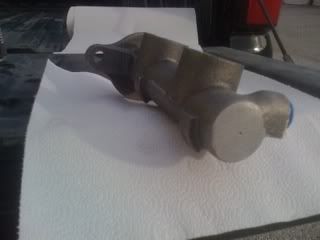
I ground off the bottom casting "imperfections"
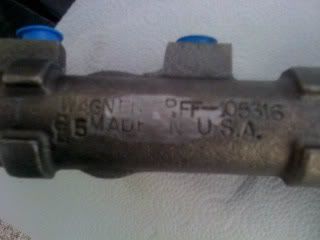
I painted it with some aluminum color paint I had from a previous project.
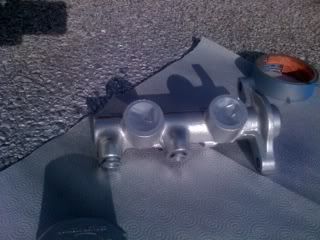
I ground off the front casting "imperfections"

I ground off the bottom casting "imperfections"

I painted it with some aluminum color paint I had from a previous project.

malibudave1978
Member
- Joined
- Apr 3, 2005
- Messages
- 80
UPDATE:
I had trouble getting the brakes bled. I bench bled the system, but for some reason I couldn't get any pedal after I installed the system. I am going to use a bleeder kit to push brake fluid up to the master cylinder from the wheel cylinders and calipers. I will not be able to get to it until January 21st or 22nd, so stay tuned in until then.
Let me know if you have any questions.
I had trouble getting the brakes bled. I bench bled the system, but for some reason I couldn't get any pedal after I installed the system. I am going to use a bleeder kit to push brake fluid up to the master cylinder from the wheel cylinders and calipers. I will not be able to get to it until January 21st or 22nd, so stay tuned in until then.
Let me know if you have any questions.
malibudave1978
Member
- Joined
- Apr 3, 2005
- Messages
- 80
Purchased an additional new 7/8" bore master cylinder just in case the older new one I bought doesn't work like it is suppose to when I install it on the El Camino. When I was bench bleeding the older, new one, the front port for the rear brakes would suck the fluid back into the master cylinder after the piston was released. The rear port for the front brakes didn't have this issue.
Is this normal? I don't know, but I will find out from the new master cylinder that I bought.
I also baught a rebuilt, aluminum master cylinder, with a 1" bore, from a 1979 Buick Riviera with the optional rear disc brakes. I did this because the reservior is larger, it can be retro fitted to the 7/8" bore manual brake master cylinder, and it matched the angle of the firewall. You don't need it for rear drum brakes, but I like the extra fluid capacity.
Is this normal? I don't know, but I will find out from the new master cylinder that I bought.
I also baught a rebuilt, aluminum master cylinder, with a 1" bore, from a 1979 Buick Riviera with the optional rear disc brakes. I did this because the reservior is larger, it can be retro fitted to the 7/8" bore manual brake master cylinder, and it matched the angle of the firewall. You don't need it for rear drum brakes, but I like the extra fluid capacity.
malibudave1978
Member
- Joined
- Apr 3, 2005
- Messages
- 80
Here is a link to a person that carries new Proportioning Valves for Ford, GM, and Jeep.
http://proportionvalves.com/
Here is a link to a disc/drum PV for a g-body from the http://proportionvalves.com/ site.
http://www.carolinaclassictrucks.com/78-86-malibu-PV2.html
Here is a link to a disc/disc PV for a 2nd gen f-body that looks like it will work with g-body brake lines if you convert to rear disc brakes. Please call to confirm it will bolt in.
http://www.carolinaclassictrucks.com/79-81-TransAM-PV4.html
MOPAR MASTER CYLINDER RETROFIT
I may have found a way to retrofit a 7/8” mopar (1993 Dodge Shadow) master to a g-body for manual brakes. I have not tested this yet to see if this works.
For the Front Brake port on the Proportion Valve:
Edelmann 258350 - Adapter-Standard To Dual Master Cylinder - 3/16" Tube - 3/8-24 Female Inverted Flare Seat x 1/2-20 Male Inverted Flare
For the Rear Brake Port on the Proportion Valve:
Edelmann 258340 - Adapter-Standard To Dual Master Cylinder - 3/16" Tube - 3/8-24 Female Inverted Flare Seat x 7/16-24 Male Inverted Flare
I don’t know the length of the brake lines from the proportion valve to the mopar master, but flared lines are less than $10 each from the auto parts stores. It should be about 2 to 3 foot of line. A coat hanger can be used to find the actual length needed.
If this setup works, this will be the cheapest way to get an aluminum master cylinder retrofitted to a g-body.
Let me know if you see any issues with what has been posted above.
http://proportionvalves.com/
Here is a link to a disc/drum PV for a g-body from the http://proportionvalves.com/ site.
http://www.carolinaclassictrucks.com/78-86-malibu-PV2.html
Here is a link to a disc/disc PV for a 2nd gen f-body that looks like it will work with g-body brake lines if you convert to rear disc brakes. Please call to confirm it will bolt in.
http://www.carolinaclassictrucks.com/79-81-TransAM-PV4.html
MOPAR MASTER CYLINDER RETROFIT
I may have found a way to retrofit a 7/8” mopar (1993 Dodge Shadow) master to a g-body for manual brakes. I have not tested this yet to see if this works.
For the Front Brake port on the Proportion Valve:
Edelmann 258350 - Adapter-Standard To Dual Master Cylinder - 3/16" Tube - 3/8-24 Female Inverted Flare Seat x 1/2-20 Male Inverted Flare
For the Rear Brake Port on the Proportion Valve:
Edelmann 258340 - Adapter-Standard To Dual Master Cylinder - 3/16" Tube - 3/8-24 Female Inverted Flare Seat x 7/16-24 Male Inverted Flare
I don’t know the length of the brake lines from the proportion valve to the mopar master, but flared lines are less than $10 each from the auto parts stores. It should be about 2 to 3 foot of line. A coat hanger can be used to find the actual length needed.
If this setup works, this will be the cheapest way to get an aluminum master cylinder retrofitted to a g-body.
Let me know if you see any issues with what has been posted above.
malibudave1978
Member
- Joined
- Apr 3, 2005
- Messages
- 80
A Wilwood master cylinder will not work with the angle of a g-body firewall if the Wilwood master cylinder is bolted directly to the firewall. It physically bolts up, but there is a hole at the bottom of the master cylinder that regulates the fluid from one reservior to the other. When bolted directly to the firewall, the angle will let all the fluid run to the back reservior and the front reservior is left almost empty.
The Wilwood master should work on a TRZ , TNT, or powermaster adapter plates because these adapter plates correct the angle of the firewall and allows the master cylinder to sit horizontal (level) to the ground.
The Wilwood master should work on a TRZ , TNT, or powermaster adapter plates because these adapter plates correct the angle of the firewall and allows the master cylinder to sit horizontal (level) to the ground.
malibudave1978
Member
- Joined
- Apr 3, 2005
- Messages
- 80
I have purchased 3 different metric calipers for comparison:
**CCP big bore 2.75" bore (2.565" piston diameter) metric cast iron caliper – WEIGHT 6 lbs 11.2 oz bare with slider bushings installed
**US Brake standard bore 2.5" bore (2.376" piston diamter) metric cast iron caliper- WEIGHT 6 lbs 4.7 oz bare with slider busings installed
**Wilwood small bore 2.0" bore (1.981" piston diameter) metric cast iron caliper - WEIGHT 4 lbs 1.7 oz bare with NO SLIDER BUSHINGS INSTALLED.
A while back I purchased NEW the $59.95 each, big bore calipers from speedwaymotors.com. There was some manufacturing issues or problems with these calipers and they sent me replacement calipers. The replacement calipers are NEW CCP big bore metric calipers. PN CP412526. Online, these are the same price of $59.95 each from classicperform.com. They look exactly the same except for the paint on the calipers. The originals where painted/powder coated silver. These are painted/powder coated black. The caliper housing, compared the standard bore US Brake 2.5” calipers and 2.0" Wilwood calipers, are a different casting. The piston looks to be stainless steel and comes with a dust boot installed. The piston diameter is 2.565" in diameter. These calipers came loaded with pads, slider bolts/pins, and hose fittings. You should be able to bolt these to your car, bleed the brakes, and drive. The piston cylinder side of the caliper is roughly the same size as the as the standard 2.5” bore caliper.
I recently purchased NEW, US Brake/Afco branded 2.5” standard bore metric calipers. They are $45 to $50 each online. The casting is not painted or powder coated. They come in a right PN 7241-9003 and a left caliper PN 7241-9004. They cannot be interchanged from side to side. The piston looks to be a cast steel/iron, unlike the CCP 2.75” and Wilwood 2.0” bore calipers. They are also 2.376" in diameter which matches stock advertised piston/bore sizes. The casting looks to be a stock casting and comes with a dust boot installed. It has all the markings of a stock calipers. This caliper came unloaded with no pads, slider bolts/pins, and hose fittings. It does come with the bleeder screws and bushing inserts for the slider bolts/pins. You will have to reuse your slider pins from your stock calipers and hose fittings. You will need to purchase new pads or reuse the ones you have on your car.
I also recently purchased NEW, Wilwood 2.0” small bore metric calipers. PN 120-9333. The price is round $80 each online. It is also a different casting from the other two. Visually the casting looks better and it looks to come with a stainless steel piston that is 1.981" in diameter. The casting comes bare with no paint or powder coating and they can be interchanged from the right and left hand side of the car. The piston cylinder portion of the caliper is physically smaller than the other two because of the reduced size of the piston. The piston bore and stainless steel piston look to have a better, tighter fit. The clearance is so tight there is no dust boot installed around the piston like the 2.75” and 2.5” bore caliper above. These calipers only come with a bleeder screw. It does not come with any other hardware. You will have to supply the slider bolts/pins, slider bolt/pin bushing inserts (I need to make sure this is possible), brake pads, and hydraulic hose fittings. All hardware should be able to transfer over from your original caliper. Please refer to this web page for more details. http://www.wilwood.com/PDF/Flyers/fl176.pdf
Out of the three calipers above, I was most impressed with the Wilwood calipers. These calipers have a very clean casting that weigh at least 2 lbs less than the other two calipers. The Wilwood website list a 2.75” bore version also that weighs just 5 more ounces than the Wilwood 2.0” bore versions (4lb 6.4oz v 4lb 1.6oz). These Wilwood iron calipers weigh roughly 1lb more than the Willwood comparable aluminum metric caliper with the 2.38” bore (4lb 6.4oz v 4lb 1.6oz v 3lb 6.4oz). I also suspect that the piston to bore clearances are just as tight as their 2.0" verson which will give the 2.75" version of the Wilwood caliper a larger piston that that of the CCP version. It theory this gives more clamping force.
**CCP big bore 2.75" bore (2.565" piston diameter) metric cast iron caliper – WEIGHT 6 lbs 11.2 oz bare with slider bushings installed
**US Brake standard bore 2.5" bore (2.376" piston diamter) metric cast iron caliper- WEIGHT 6 lbs 4.7 oz bare with slider busings installed
**Wilwood small bore 2.0" bore (1.981" piston diameter) metric cast iron caliper - WEIGHT 4 lbs 1.7 oz bare with NO SLIDER BUSHINGS INSTALLED.
A while back I purchased NEW the $59.95 each, big bore calipers from speedwaymotors.com. There was some manufacturing issues or problems with these calipers and they sent me replacement calipers. The replacement calipers are NEW CCP big bore metric calipers. PN CP412526. Online, these are the same price of $59.95 each from classicperform.com. They look exactly the same except for the paint on the calipers. The originals where painted/powder coated silver. These are painted/powder coated black. The caliper housing, compared the standard bore US Brake 2.5” calipers and 2.0" Wilwood calipers, are a different casting. The piston looks to be stainless steel and comes with a dust boot installed. The piston diameter is 2.565" in diameter. These calipers came loaded with pads, slider bolts/pins, and hose fittings. You should be able to bolt these to your car, bleed the brakes, and drive. The piston cylinder side of the caliper is roughly the same size as the as the standard 2.5” bore caliper.
I recently purchased NEW, US Brake/Afco branded 2.5” standard bore metric calipers. They are $45 to $50 each online. The casting is not painted or powder coated. They come in a right PN 7241-9003 and a left caliper PN 7241-9004. They cannot be interchanged from side to side. The piston looks to be a cast steel/iron, unlike the CCP 2.75” and Wilwood 2.0” bore calipers. They are also 2.376" in diameter which matches stock advertised piston/bore sizes. The casting looks to be a stock casting and comes with a dust boot installed. It has all the markings of a stock calipers. This caliper came unloaded with no pads, slider bolts/pins, and hose fittings. It does come with the bleeder screws and bushing inserts for the slider bolts/pins. You will have to reuse your slider pins from your stock calipers and hose fittings. You will need to purchase new pads or reuse the ones you have on your car.
I also recently purchased NEW, Wilwood 2.0” small bore metric calipers. PN 120-9333. The price is round $80 each online. It is also a different casting from the other two. Visually the casting looks better and it looks to come with a stainless steel piston that is 1.981" in diameter. The casting comes bare with no paint or powder coating and they can be interchanged from the right and left hand side of the car. The piston cylinder portion of the caliper is physically smaller than the other two because of the reduced size of the piston. The piston bore and stainless steel piston look to have a better, tighter fit. The clearance is so tight there is no dust boot installed around the piston like the 2.75” and 2.5” bore caliper above. These calipers only come with a bleeder screw. It does not come with any other hardware. You will have to supply the slider bolts/pins, slider bolt/pin bushing inserts (I need to make sure this is possible), brake pads, and hydraulic hose fittings. All hardware should be able to transfer over from your original caliper. Please refer to this web page for more details. http://www.wilwood.com/PDF/Flyers/fl176.pdf
Out of the three calipers above, I was most impressed with the Wilwood calipers. These calipers have a very clean casting that weigh at least 2 lbs less than the other two calipers. The Wilwood website list a 2.75” bore version also that weighs just 5 more ounces than the Wilwood 2.0” bore versions (4lb 6.4oz v 4lb 1.6oz). These Wilwood iron calipers weigh roughly 1lb more than the Willwood comparable aluminum metric caliper with the 2.38” bore (4lb 6.4oz v 4lb 1.6oz v 3lb 6.4oz). I also suspect that the piston to bore clearances are just as tight as their 2.0" verson which will give the 2.75" version of the Wilwood caliper a larger piston that that of the CCP version. It theory this gives more clamping force.
malibudave1978
Member
- Joined
- Apr 3, 2005
- Messages
- 80
Pics of the CCP 2.75" Big Bore Metric Caliper
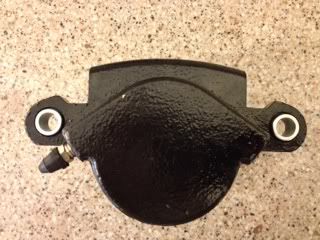
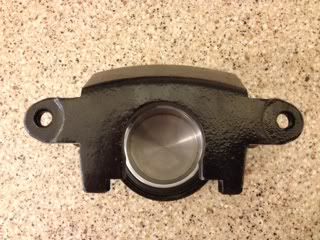
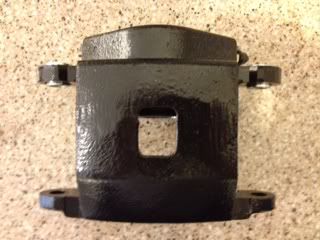
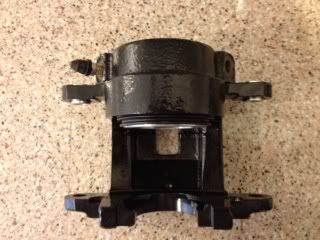
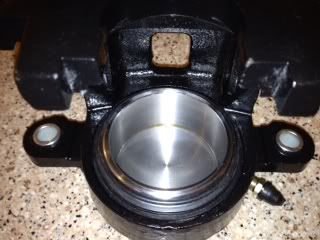







malibudave1978
Member
- Joined
- Apr 3, 2005
- Messages
- 80
Pics of US Brakes / AFCO 2.5" Driver's Side Metric Caliper
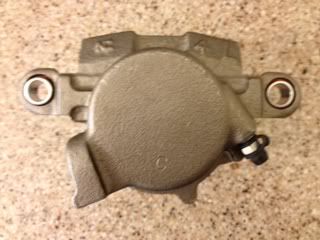
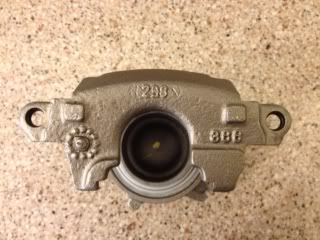
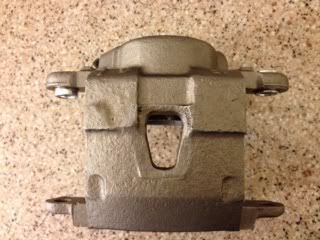
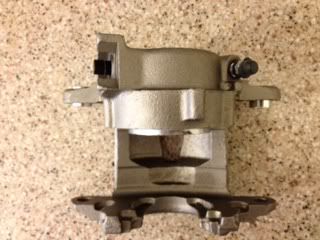
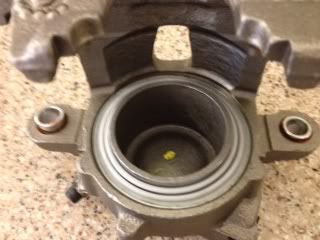







malibudave1978
Member
- Joined
- Apr 3, 2005
- Messages
- 80
Pics of Wilwood 2.0" Bore Metric Caliper
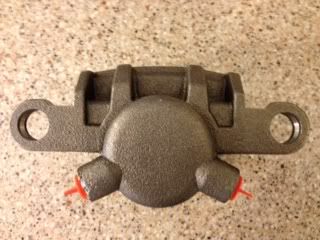
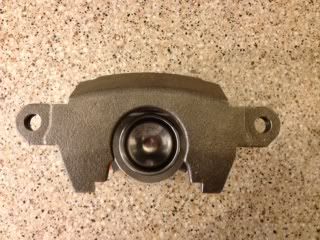
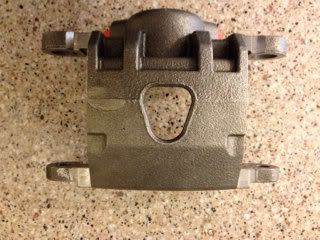
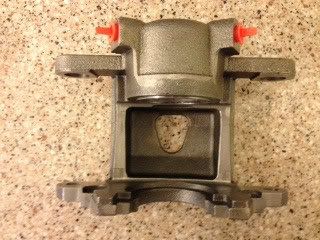
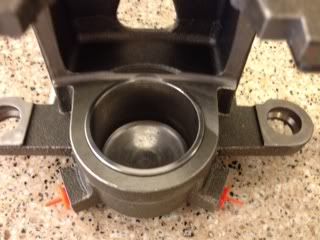
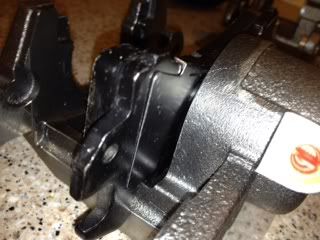






malibudave1978
Member
- Joined
- Apr 3, 2005
- Messages
- 80
I purchased my second new master cylinder from rockauto.com a while back and just now had time to install it. The master cylinder is a Centric brand PN# 130.62005. It is a manual brake master cylinder for a g-body with a 7/8" bore. I installed it and bleed the brakes from back to front and got a good, firm pedal. I left the speedway motors recalled calipers installed, for now, to see how the system all worked together. I noticed, while I was under the car bleeding the brakes, I saw a lot of caliper defection as my dad pumped the brake pedal when the bleeder screws where closed.
How did it do? For the setup I have, it did very well. I could not lock up the front brakes, but the braking felt more confident than when I had the stock, 24mm bore power master cylinder . I felt, if I was driving this on the street a lot, I wouldn't have to anticipate my braking. I felt I could stop where I wanted to when I wanted to under normal street driving. As expected, the pedal stroke is longer than a power brake pedal.
What would I do different? I would find a better front caliper. I think I will try the Wilwood single piston, 2.75" bore, metric caliper. From my experience with the inspection of 2" bore, Wilwood, single piston, metric calipers, I think the 2.75" big bore Wilwood will have a larger piston that the CCP/Speedway Motors 2.75" big bore caliper. I just worry that any 7/8" bore master cylinder may not have the volume of brake fluid needed to make these work.
How did it do? For the setup I have, it did very well. I could not lock up the front brakes, but the braking felt more confident than when I had the stock, 24mm bore power master cylinder . I felt, if I was driving this on the street a lot, I wouldn't have to anticipate my braking. I felt I could stop where I wanted to when I wanted to under normal street driving. As expected, the pedal stroke is longer than a power brake pedal.
What would I do different? I would find a better front caliper. I think I will try the Wilwood single piston, 2.75" bore, metric caliper. From my experience with the inspection of 2" bore, Wilwood, single piston, metric calipers, I think the 2.75" big bore Wilwood will have a larger piston that the CCP/Speedway Motors 2.75" big bore caliper. I just worry that any 7/8" bore master cylinder may not have the volume of brake fluid needed to make these work.
malibudave1978
Member
- Joined
- Apr 3, 2005
- Messages
- 80
Things I learned from this process.
*New stock manual brake g-body master cylinders are hit or miss in functionality. My first new one I bought did not work, but it was a clearance item from rockauto.com. I ended up spending another $80 plus shipping for the Centric brand one that actually worked.
*The larger the caliper piston is the better the clamping force.
*Caliper deflection affects brake performance more that I thought.
*The smaller the bore of the master cylinder is the better the pressure to the caliper.
*But if the bore of the master cylinder is to small, it may not have enough fluid to fully compress the caliper piston.
*The diameter of the brake rotor also affects the performace of the brakes not only because of rotor area and heat dissipaton, but also a larger diameter rotor gives the brakes greater leverage. Just think of using a 6" long breaker bar instead of a 5.25" braker bar to get a bolt loose. A longer bar will have a easier time getting the bolt loose. A 10.5" rotor has a 5.25" (half the rotor diameter) of "leverage". A 12" rotor has 6" of "leverage". Larger is better.
*They make brake pad designed for drag racers. They work better when cold and are for vehicles that do not use their brakes on a daily basis.
*Wilwood makes nice metric calipers.
*New stock manual brake g-body master cylinders are hit or miss in functionality. My first new one I bought did not work, but it was a clearance item from rockauto.com. I ended up spending another $80 plus shipping for the Centric brand one that actually worked.
*The larger the caliper piston is the better the clamping force.
*Caliper deflection affects brake performance more that I thought.
*The smaller the bore of the master cylinder is the better the pressure to the caliper.
*But if the bore of the master cylinder is to small, it may not have enough fluid to fully compress the caliper piston.
*The diameter of the brake rotor also affects the performace of the brakes not only because of rotor area and heat dissipaton, but also a larger diameter rotor gives the brakes greater leverage. Just think of using a 6" long breaker bar instead of a 5.25" braker bar to get a bolt loose. A longer bar will have a easier time getting the bolt loose. A 10.5" rotor has a 5.25" (half the rotor diameter) of "leverage". A 12" rotor has 6" of "leverage". Larger is better.
*They make brake pad designed for drag racers. They work better when cold and are for vehicles that do not use their brakes on a daily basis.
*Wilwood makes nice metric calipers.
malibudave1978
Member
- Joined
- Apr 3, 2005
- Messages
- 80
Just recieved my Wilwood 2.75" big bore calipers in today. These are very nice calipers, just like the Wilwood 2 inch metric calipers. The piston diameter measures 2.704 inches. On the underside of the caliper, there are ridges that bridge the piston side (inside) of the caliper to the wheel side (outside) of the caliper. These ridges are not present on any of the other calipers. These ridges should cut down of caliper deflection. The weight of each of the 2.75" calipers is 4 lbs 8.6 ounces with out the bleeder screw. I hope the 7/8" bore g-body manual brake master cylinder can handle the increase in volume these calipers may require.
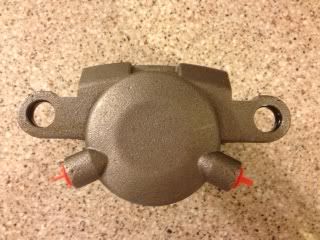
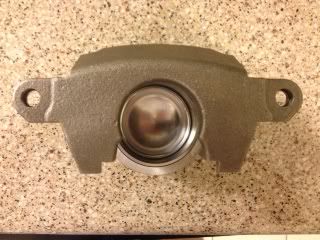
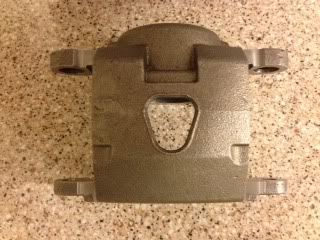
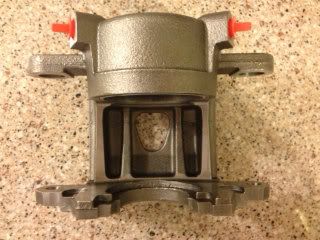
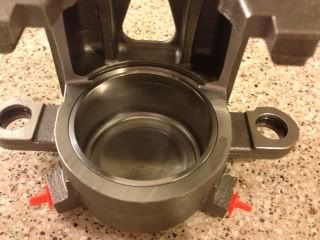





malibudave1978
Member
- Joined
- Apr 3, 2005
- Messages
- 80
Caliper Specs
Caliper...............................Part Number........Advertised Bore Size.......Actual Piston Size.....Weight
Wilwood 2" Bore Caliper........PN 120-9333...................2.00"..........................1.981"................4lb 1.6oz
US Brake / AFCO Caliper.......PN 7241-9004..................2.50"..........................2.376"................6lb 4.7oz
CCP Big Bore Caliper............PN CP412526...................2.75"...........................2.565"................6lb 11.2oz
Wilwood 2.75" Bore Caliper....PN 120-8926...................2.75"...........................2.704"................4lb 8.6oz
Caliper...............................Part Number........Advertised Bore Size.......Actual Piston Size.....Weight
Wilwood 2" Bore Caliper........PN 120-9333...................2.00"..........................1.981"................4lb 1.6oz
US Brake / AFCO Caliper.......PN 7241-9004..................2.50"..........................2.376"................6lb 4.7oz
CCP Big Bore Caliper............PN CP412526...................2.75"...........................2.565"................6lb 11.2oz
Wilwood 2.75" Bore Caliper....PN 120-8926...................2.75"...........................2.704"................4lb 8.6oz
malibudave1978
Member
- Joined
- Apr 3, 2005
- Messages
- 80
This week I put on the Wilwood big bore calipers. I got them bled and immediately had less pedal pressure when using the 7/8” G-Body manual brake master cylinder. The pedal almost went to the floor. I assume it is from the increased piston diameter over the Speedwaymotors.com “Big Bore” calipers (2.704” Wilwood v 2.565” Speedwaymotors/CCP) that I replaced. When driving with the Wilwood big bore calipers, I could pump the pedal 3 or 4 times and get the pressure I needed and would lock up the right rear tire and stop the car just like the other calipers. I suspect now I will need a 24mm bore G-body master cylinder (from a power, vacuum boosted G-body) and EE rated front pads to replace the FF rated front pads I have on the front now. The EE rated front pads have better “bite” when the rotor is colder. FF rated front pads have better “bite” when the rotor heats up. Since this is a street driven car, the EE rated pads should be a better choice and will match the rear EE rated shoes that are already on the car.
malibudave
New Member
- Joined
- Apr 14, 2004
- Messages
- 16
I am done testing the manual brake setup with a stock, aluminum, rebuilt, 24mm bore, 1980 El Camino master cylinder. With only this change, I got back the brake fluid pressure that I lost when I upgraded to the Wilwood 2.75” metric calipers using the 7/8” bore master cylinder. I bench bleed the master cylinder installed it in place of the 7/8” bore master cylinder, bled the line at the master cylinder, and then bled the car at all four wheels.
On the test drive, using the 24mm master, I did a few hard stops from about 30 mph. I was rewarded with both rear wheels locking up, but the front braking system felt as if it still wasn’t grabbing. After the testing, I jacked the front of the car and removed the wheels and I unbolted the calipers so I can take a look at the pads. I suppose during my very first manual brake test, I did not bed the brakes in properly and I glazed the brake pads over. I do not know why I did not notice this when I put on the Wilwood calipers other than not recognizing what glazed pads look like. The glazing most likely happened because I had a large master cylinder and small calipers on my first manual brake test and, at the time, I wasn’t getting enough pressure to the pads to do accomplish correct bedding. The moral of the story is to bed your pads properly.
Good news is that I found out what the issue is with the front brakes not grabbing. Bad news is that I didn’t deglaze my pads and retest. I didn’t deglaze the pads I originally used because went ahead and upgraded to a Wilwood Polymatrix A brake pad.
I went to the Wilwood PolymatrixA pad because of its good, cold clamping properties and, before I realized about the glazing pads, I had thought this would help with front brakes. **As a warning from Wilwood to any one using these pads, Wilwood considers these race pads**. These are aggressive pads and will most likely wear the front rotors prematurely and are intended for race use only. These pads have almost twice the friction coefficient as a “stock” type pad. I am using this aggressive pad because the front rotors are small, the brake pads are small, the front calipers are a floating design, and the car is now has manual brakes. These pads are also a wallet buster at $150 a set.
The braking test with these pads where a noticeable night a day difference. I felt very comfortable and confident while driving and stopping. On hard stops, the nose of the car would “dive” down and the rear wheels still locked up. Only time will tell if these front pads are good for everyday use with this manual brake setup.
If your car is a daily driver and not a drag car, you most likely do not need to change out to larger wheel cylinders on the rear drum brakes like I did. The original stock 3/4” bore wheel cylinders versus the larger 7/8” bore wheel cylinders should reduce rear lock up on hard braking.
For a drag racer with large, wide, sticky tires on the back, the larger 7/8” bore wheel cylinder may be better to keep the rear tires from spinning when your holding the car on the line with just the brakes. An aggressive front pad may also be needed to hold the car on the line (contact one of the major brake pad manufactures for suggestions).
From my experience, to do a manual brake system on a g-body or s-10, some or all of the brake components will have to be replaced. You cannot just remove the vacuum booster and bolt the master cylinder to the firewall and expect your braking to function well. It is a system approach.
Do you need an oversized caliper? In my opinion, no you do not.
Do you need to change out the front calipers? In my opinion, yes you do. Why? Because the stock calipers may or may not be a LOW DRAG design which requires a step bore master cylinder. How do you know that you have LOW DRAG calipers? You actually cannot physically tell, so its best to buy aftermarket calipers to cut down on variables that may cause trouble with your braking system.
Do I recommend rebuilt front calipers from the auto parts store? No. See above.
Do you need to change out the master cylinder? In my opinion, most likely you will need to. Why? It depends on what you are starting with. If you have a GM g-body vehicle that was built from 1978 to 1980, you have a strait bore, 24mm bore master cylinder from the factory and you can just upgrade to Wilwood 2.75” bore calipers if you master cylinder is in good working order. If you have a vehicle built from 1981 through 2003 you most likely have a step bore master cylinder. These master cylinders are too large for almost all manual brake conversions on a g-body or s-10. Now a choice has to be made. How much money do you want to spend on aftermarket front calipers? Cheapest ones that I have found are around $45 each with a stock size bore from U.S. Brakes. You will then need a 7/8” bore master cylinder to match to these front calipers. For a g-body car you can go with a new or rebuilt, stock replacement from a 1978 to 1980 g-body manual brake master cylinder. For an S-10, the only option I have found that readily bolts to the firewall and to the brake lines is a Wilwood 7/8” bore master cylinder. If upgrading to the Wilwood 2.75” bore calipers, you will need a 24mm master cylinder. The g-body options are a new or built stock power brake unit from a 1978 to 1980 g-body car. New ones will be cast iron. Most rebuilt ones will be cast iron. For some reason, the 1980 model years came in aluminum and these can be bought rebuilt (like I have installed in the latest test). For a s-10, you can use a stock replacement manual brake master cylinder from a 1982 to 1992 s-10 truck with manual brakes. These are step bore master cylinders with a primary bore of 1-1/4” and a secondary bore of 24mm. I do not recommend these master cylinders because they are hard to bleed and have a bypass valve that can fail. The other options are a 24mm Wilwood master cylinder and a 1990s 24mm Dodge Dakota master cylinder. Only issue with the Dakota master is the rear brake port is 9/16-20 instead of 9/16-18. I have found no adapter for this conversion yet.
Do I recommend step bore master cylinders? No, because they are generally too large for a stock size front caliper, they are hard to bleed, and they have a bypass valve that may fail. These three issues can be remedied by using a correct size strait bore master cylinder. A 7/8” bore master cylinder for stock bore, aftermarket calipers and 24mm bore master cylinder for a Wilwood 2.75” bore calipers.
Do I recommend other oversized front calipers other than the Wilwood 2.75” front calipers? No, because their piston size in these oversized calipers are not much larger than stock. The Wilwood caliper, visually, looks to be engineered better.
Do I recommend stock size calipers? U.S. Brake is the only caliper, of the aftermarket cast iron replacements I know, that is not a low drag caliper. There may be other aftermarket, “metric” calipers, but I cannot confirm if they are low drag or not. The U.S. Brake calipers are based on a stock casting. The other alternative is a stock, replacement aluminum, “metric” caliper from Wilwood. I have not used or viewed one of these calipers, but from engineering of the 2.75” bore and 2.00” bore calipers I have viewed, I suspect they should be just as well engineered and lighter.
Do I recommend larger wheel cylinders? If the car is street driven, most likely no. If drag raced, most likely yes to keep the rear tires from spinning when doing a brake stand
Do I recommend braided stainless steel flex lines? Yes, for the reduced ballooning and better pedal feel, but is not necessary.
On the test drive, using the 24mm master, I did a few hard stops from about 30 mph. I was rewarded with both rear wheels locking up, but the front braking system felt as if it still wasn’t grabbing. After the testing, I jacked the front of the car and removed the wheels and I unbolted the calipers so I can take a look at the pads. I suppose during my very first manual brake test, I did not bed the brakes in properly and I glazed the brake pads over. I do not know why I did not notice this when I put on the Wilwood calipers other than not recognizing what glazed pads look like. The glazing most likely happened because I had a large master cylinder and small calipers on my first manual brake test and, at the time, I wasn’t getting enough pressure to the pads to do accomplish correct bedding. The moral of the story is to bed your pads properly.
Good news is that I found out what the issue is with the front brakes not grabbing. Bad news is that I didn’t deglaze my pads and retest. I didn’t deglaze the pads I originally used because went ahead and upgraded to a Wilwood Polymatrix A brake pad.
I went to the Wilwood PolymatrixA pad because of its good, cold clamping properties and, before I realized about the glazing pads, I had thought this would help with front brakes. **As a warning from Wilwood to any one using these pads, Wilwood considers these race pads**. These are aggressive pads and will most likely wear the front rotors prematurely and are intended for race use only. These pads have almost twice the friction coefficient as a “stock” type pad. I am using this aggressive pad because the front rotors are small, the brake pads are small, the front calipers are a floating design, and the car is now has manual brakes. These pads are also a wallet buster at $150 a set.
The braking test with these pads where a noticeable night a day difference. I felt very comfortable and confident while driving and stopping. On hard stops, the nose of the car would “dive” down and the rear wheels still locked up. Only time will tell if these front pads are good for everyday use with this manual brake setup.
If your car is a daily driver and not a drag car, you most likely do not need to change out to larger wheel cylinders on the rear drum brakes like I did. The original stock 3/4” bore wheel cylinders versus the larger 7/8” bore wheel cylinders should reduce rear lock up on hard braking.
For a drag racer with large, wide, sticky tires on the back, the larger 7/8” bore wheel cylinder may be better to keep the rear tires from spinning when your holding the car on the line with just the brakes. An aggressive front pad may also be needed to hold the car on the line (contact one of the major brake pad manufactures for suggestions).
From my experience, to do a manual brake system on a g-body or s-10, some or all of the brake components will have to be replaced. You cannot just remove the vacuum booster and bolt the master cylinder to the firewall and expect your braking to function well. It is a system approach.
Do you need an oversized caliper? In my opinion, no you do not.
Do you need to change out the front calipers? In my opinion, yes you do. Why? Because the stock calipers may or may not be a LOW DRAG design which requires a step bore master cylinder. How do you know that you have LOW DRAG calipers? You actually cannot physically tell, so its best to buy aftermarket calipers to cut down on variables that may cause trouble with your braking system.
Do I recommend rebuilt front calipers from the auto parts store? No. See above.
Do you need to change out the master cylinder? In my opinion, most likely you will need to. Why? It depends on what you are starting with. If you have a GM g-body vehicle that was built from 1978 to 1980, you have a strait bore, 24mm bore master cylinder from the factory and you can just upgrade to Wilwood 2.75” bore calipers if you master cylinder is in good working order. If you have a vehicle built from 1981 through 2003 you most likely have a step bore master cylinder. These master cylinders are too large for almost all manual brake conversions on a g-body or s-10. Now a choice has to be made. How much money do you want to spend on aftermarket front calipers? Cheapest ones that I have found are around $45 each with a stock size bore from U.S. Brakes. You will then need a 7/8” bore master cylinder to match to these front calipers. For a g-body car you can go with a new or rebuilt, stock replacement from a 1978 to 1980 g-body manual brake master cylinder. For an S-10, the only option I have found that readily bolts to the firewall and to the brake lines is a Wilwood 7/8” bore master cylinder. If upgrading to the Wilwood 2.75” bore calipers, you will need a 24mm master cylinder. The g-body options are a new or built stock power brake unit from a 1978 to 1980 g-body car. New ones will be cast iron. Most rebuilt ones will be cast iron. For some reason, the 1980 model years came in aluminum and these can be bought rebuilt (like I have installed in the latest test). For a s-10, you can use a stock replacement manual brake master cylinder from a 1982 to 1992 s-10 truck with manual brakes. These are step bore master cylinders with a primary bore of 1-1/4” and a secondary bore of 24mm. I do not recommend these master cylinders because they are hard to bleed and have a bypass valve that can fail. The other options are a 24mm Wilwood master cylinder and a 1990s 24mm Dodge Dakota master cylinder. Only issue with the Dakota master is the rear brake port is 9/16-20 instead of 9/16-18. I have found no adapter for this conversion yet.
Do I recommend step bore master cylinders? No, because they are generally too large for a stock size front caliper, they are hard to bleed, and they have a bypass valve that may fail. These three issues can be remedied by using a correct size strait bore master cylinder. A 7/8” bore master cylinder for stock bore, aftermarket calipers and 24mm bore master cylinder for a Wilwood 2.75” bore calipers.
Do I recommend other oversized front calipers other than the Wilwood 2.75” front calipers? No, because their piston size in these oversized calipers are not much larger than stock. The Wilwood caliper, visually, looks to be engineered better.
Do I recommend stock size calipers? U.S. Brake is the only caliper, of the aftermarket cast iron replacements I know, that is not a low drag caliper. There may be other aftermarket, “metric” calipers, but I cannot confirm if they are low drag or not. The U.S. Brake calipers are based on a stock casting. The other alternative is a stock, replacement aluminum, “metric” caliper from Wilwood. I have not used or viewed one of these calipers, but from engineering of the 2.75” bore and 2.00” bore calipers I have viewed, I suspect they should be just as well engineered and lighter.
Do I recommend larger wheel cylinders? If the car is street driven, most likely no. If drag raced, most likely yes to keep the rear tires from spinning when doing a brake stand
Do I recommend braided stainless steel flex lines? Yes, for the reduced ballooning and better pedal feel, but is not necessary.
malibudave1978
Member
- Joined
- Apr 3, 2005
- Messages
- 80
Here is a list of strait bore master cylinders that will bolt up to a G-body’s angled firewall when using a flat, manual brake adapter plate. This is a list from smallest to largest.
21mm (0.826”) bore 1993 Dodge Shadow master cylinder (other years and models may work)
• Requires adapters to mate master cylinder outlet to stock lines. The adapter Part number is MC-SF at http://www.classicperform.com.
• Mounting holes spaced 3.25” versus GM master cylinder’s 3.375”.
• Hard to find.
• Light in weight.
• Advertised as 21mm, but may be delivered in 7/8” or 24mm bores. Measure bore size before you buy. Rebuilt/Used ones will have a “1” cast into the front of the aluminium body under the reservoir.
• Can buy new or used. New ones are fairly cheap to purchase.
• Aluminium body – new, used, or rebuilt.
• Large reservoir can hold enough fluid for rear disc brakes.
7/8” (0.875”) bore 1978-1980 GM G-body manual brake master cylinders.
• Can buy new or used. Rebuilt are fairly cheap. New are fairly expensive.
• Reservoir too small for rear disc brakes. The reservoir from 1979 Buick Riviera with four wheel disc brakes can be retrofitted to this master cylinder.
• Advertised as manual brake units, but may be delivered as a 24mm, vacuum power boosted unit. Measure bore size before you buy.
• Bolt in.
• Cast iron body – new, used, or rebuilt. (no aluminium)
7/8” (0.875”) bore 1993 Dodge Shadow master cylinder (other years and models may work)
• Requires adapters to mate master cylinder outlet to stock lines. The adapter Part number is MC-SF at http://www.classicperform.com.
• Mounting holes spaced 3.25” versus GM master cylinder’s 3.375”.
• Easier to find.
• Light in weight.
• Advertised as 7/8”, but may be delivered in a 24mm bore. Measure bore size before you buy.
• Rebuilt/Used ones will have an “8” cast into the front of the aluminium body under the reservoir.
• Can buy new or used. New ones are fairly cheap to purchase.
• Aluminium body – new, used, or rebuilt.
• Large reservoir can hold enough fluid for rear disc brakes.
24mm (0.944”) bore 1978-1980 GM G-body power brake master cylinders.
• Can buy new or used. Used are fairly cheap. New are fairly expensive.
• Reservoir too small for rear disc brakes. The reservoir from 1979 Buick Riviera with four wheel disc brakes can be retrofitted to this master cylinder.
• Bolt in.
• Come in cast iron and aluminium. 1978-1979 are cast iron. 1980 is aluminium (some models i.e. El Camino).
• New master cylinders will most likely be cast iron regardless of year.
• Rebuilt units come in cast iron and aluminium (1980 – some models).
24mm (0.944”) bore 1993 Dodge Shadow master cylinder (other years and models may work)
• Requires adapters to mate master cylinder outlet to stock lines. The adapter Part number is MC-SF at http://www.classicperform.com.
• Mounting holes spaced 3.25” versus GM master cylinder’s 3.375”.
• Easiest to find.
• Light in weight.
• Advertised as 24mm, but may be delivered in a 7/8” bore. Measure bore size before you buy.
• Rebuilt/Used ones will have a “4” cast into the front of the aluminium body under the reservoir.
• Can buy new or used. New ones are fairly cheap to purchase.
• Aluminium body – new, used, or rebuilt.
• Large reservoir can hold enough fluid for rear disc brakes.
24mm (0.944”) bore 1993 Dodge Dakota master cylinder (other years and models may work)
• Rear brake line outlet is 9/16-20 versus GM rear brake line fitting of 9/16-18. The fitting for GM brake line may be used to “rethread” the master cylinder’s outlet.
• Front brake lines bolt up.
• Mounting holes spaced 3.25” versus GM master cylinder’s 3.375”.
• Can buy new or used. New ones are fairly cheap to purchase.
• Aluminium body – new, used, or rebuilt.
• Large reservoir can hold enough fluid for rear disc brakes.
• Reservoir not angled like above Dodge and GM master cylinders.
1.0” bore 1979 Buick Riviera with 4 Wheel Disc Brakes.
• Can buy new or used. Used are fairly cheap. New are fairly expensive.
• Reservoir is made for rear disc brakes.
• Bolt in.
• Come in cast iron and aluminium.
• New master cylinders will most likely be cast iron.
• Rebuilt units usually come in aluminium.
1 1/32” (1.03”) bore 1985 Dodge Diplomat master cylinder (other years and models may work)
• Rear brake line outlet is 9/16-20 versus GM rear brake line fitting of 9/16-18. Fitting for GM brake line may be used to “rethread” the master cylinder’s outlet.
• Front brake lines bolt up.
• Mounting holes spaced 3.25” versus GM master cylinder’s 3.375”.
• Can buy new or used. New ones are fairly cheap to purchase.
• Aluminium body – new, used, or rebuilt.
• Large reservoir can hold enough fluid for rear disc brakes.
• Reservoir not angled like above Dodge and GM master cylinders.
1 1/8” (1.125”) bore 1985 Dodge Ram master cylinder (other years and models may work)• Rear brake line outlet is 9/16-20 versus GM rear brake line fitting of 9/16-18. Fitting for GM brake line may be used to “rethread” the master cylinder’s outlet.
• Front brake lines bolt up.
• Mounting holes spaced 3.25” versus GM master cylinder’s 3.375”.
• Can buy new or used. New ones are fairly cheap to purchase.
• Aluminium body – new, used, or rebuilt.
• Large reservoir can hold enough fluid for rear disc brakes.
• Reservoir not angled like above Dodge and GM master cylinders.
21mm (0.826”) bore 1993 Dodge Shadow master cylinder (other years and models may work)
• Requires adapters to mate master cylinder outlet to stock lines. The adapter Part number is MC-SF at http://www.classicperform.com.
• Mounting holes spaced 3.25” versus GM master cylinder’s 3.375”.
• Hard to find.
• Light in weight.
• Advertised as 21mm, but may be delivered in 7/8” or 24mm bores. Measure bore size before you buy. Rebuilt/Used ones will have a “1” cast into the front of the aluminium body under the reservoir.
• Can buy new or used. New ones are fairly cheap to purchase.
• Aluminium body – new, used, or rebuilt.
• Large reservoir can hold enough fluid for rear disc brakes.
7/8” (0.875”) bore 1978-1980 GM G-body manual brake master cylinders.
• Can buy new or used. Rebuilt are fairly cheap. New are fairly expensive.
• Reservoir too small for rear disc brakes. The reservoir from 1979 Buick Riviera with four wheel disc brakes can be retrofitted to this master cylinder.
• Advertised as manual brake units, but may be delivered as a 24mm, vacuum power boosted unit. Measure bore size before you buy.
• Bolt in.
• Cast iron body – new, used, or rebuilt. (no aluminium)
7/8” (0.875”) bore 1993 Dodge Shadow master cylinder (other years and models may work)
• Requires adapters to mate master cylinder outlet to stock lines. The adapter Part number is MC-SF at http://www.classicperform.com.
• Mounting holes spaced 3.25” versus GM master cylinder’s 3.375”.
• Easier to find.
• Light in weight.
• Advertised as 7/8”, but may be delivered in a 24mm bore. Measure bore size before you buy.
• Rebuilt/Used ones will have an “8” cast into the front of the aluminium body under the reservoir.
• Can buy new or used. New ones are fairly cheap to purchase.
• Aluminium body – new, used, or rebuilt.
• Large reservoir can hold enough fluid for rear disc brakes.
24mm (0.944”) bore 1978-1980 GM G-body power brake master cylinders.
• Can buy new or used. Used are fairly cheap. New are fairly expensive.
• Reservoir too small for rear disc brakes. The reservoir from 1979 Buick Riviera with four wheel disc brakes can be retrofitted to this master cylinder.
• Bolt in.
• Come in cast iron and aluminium. 1978-1979 are cast iron. 1980 is aluminium (some models i.e. El Camino).
• New master cylinders will most likely be cast iron regardless of year.
• Rebuilt units come in cast iron and aluminium (1980 – some models).
24mm (0.944”) bore 1993 Dodge Shadow master cylinder (other years and models may work)
• Requires adapters to mate master cylinder outlet to stock lines. The adapter Part number is MC-SF at http://www.classicperform.com.
• Mounting holes spaced 3.25” versus GM master cylinder’s 3.375”.
• Easiest to find.
• Light in weight.
• Advertised as 24mm, but may be delivered in a 7/8” bore. Measure bore size before you buy.
• Rebuilt/Used ones will have a “4” cast into the front of the aluminium body under the reservoir.
• Can buy new or used. New ones are fairly cheap to purchase.
• Aluminium body – new, used, or rebuilt.
• Large reservoir can hold enough fluid for rear disc brakes.
24mm (0.944”) bore 1993 Dodge Dakota master cylinder (other years and models may work)
• Rear brake line outlet is 9/16-20 versus GM rear brake line fitting of 9/16-18. The fitting for GM brake line may be used to “rethread” the master cylinder’s outlet.
• Front brake lines bolt up.
• Mounting holes spaced 3.25” versus GM master cylinder’s 3.375”.
• Can buy new or used. New ones are fairly cheap to purchase.
• Aluminium body – new, used, or rebuilt.
• Large reservoir can hold enough fluid for rear disc brakes.
• Reservoir not angled like above Dodge and GM master cylinders.
1.0” bore 1979 Buick Riviera with 4 Wheel Disc Brakes.
• Can buy new or used. Used are fairly cheap. New are fairly expensive.
• Reservoir is made for rear disc brakes.
• Bolt in.
• Come in cast iron and aluminium.
• New master cylinders will most likely be cast iron.
• Rebuilt units usually come in aluminium.
1 1/32” (1.03”) bore 1985 Dodge Diplomat master cylinder (other years and models may work)
• Rear brake line outlet is 9/16-20 versus GM rear brake line fitting of 9/16-18. Fitting for GM brake line may be used to “rethread” the master cylinder’s outlet.
• Front brake lines bolt up.
• Mounting holes spaced 3.25” versus GM master cylinder’s 3.375”.
• Can buy new or used. New ones are fairly cheap to purchase.
• Aluminium body – new, used, or rebuilt.
• Large reservoir can hold enough fluid for rear disc brakes.
• Reservoir not angled like above Dodge and GM master cylinders.
1 1/8” (1.125”) bore 1985 Dodge Ram master cylinder (other years and models may work)• Rear brake line outlet is 9/16-20 versus GM rear brake line fitting of 9/16-18. Fitting for GM brake line may be used to “rethread” the master cylinder’s outlet.
• Front brake lines bolt up.
• Mounting holes spaced 3.25” versus GM master cylinder’s 3.375”.
• Can buy new or used. New ones are fairly cheap to purchase.
• Aluminium body – new, used, or rebuilt.
• Large reservoir can hold enough fluid for rear disc brakes.
• Reservoir not angled like above Dodge and GM master cylinders.
Similar threads
8
1K
2
1K
Online statistics
- Members online
- 17
- Guests online
- 5,902
- Total visitors
- 5,919
Totals may include hidden visitors.
